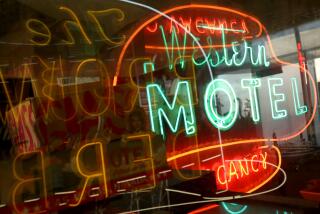Nervy Neon : It Dares Designers to Tame Its Moods
- Share via
When we think of neon, it’s usually in conjunction with Art Deco restaurants and nightclubs full of hard surfaces and brassy music. These days, however, lighting specialists are using neon to achieve an opposite end, to dramatically enhance discrete areas in private homes.
Neon dares designers to be subtle. It is a light source that insists on claiming one’s attention. It can easily overwhelm other design elements. Even in a large home, a bit of neon goes a long way.
“A house that would use neon would have to be contemporary, postmodern,” says Tustin lighting designer and architect John Lomeli. “It doesn’t lend itself to a classic, traditional house.”
While neon is being used in new ways, it remains more fashionable than functional. “Neon is nothing new; it’s coming around for the second or third time,” Lomeli says. “I think it came back because Art Deco came back.”
Designers face a challenge in taming its attention-grabbing nature, but neon seems to be going through a boomlet because it has a number of attractive qualities.
“There are variables you have with neon that you don’t have with fluorescent light,” says Sam Barker, president of Sebco Distributing, a Santa Ana firm that specializes in low-voltage, energy-efficient and decorative lighting.
Designers use neon to provide a soft reflected light around the roof line of a room, or to draw attention to a piece of art. Often, the neon itself is the artwork. “It’s decorative lighting, not task lighting,” Lomeli points out, adding that it is popular for use in coves because it gives depth and form to an architectural detail.
Although neon isn’t a light source to read by, it has several advantages over fluorescent light that make it highly effective in some situations.
“Neon is a detached element. You can put it on the ceiling, on the walls, on the floor, because it doesn’t have to do anything,” Lomeli says.
Neon is dimmable, and it comes in more than 50 colors, including eight shades of white. Neon tubes will also last for 2,000 to 50,000 hours, compared to 750 hours for an average incandescent light bulb.
Neon lighting uses a transformer at one end of the tube to excite the neon gas. The excited neon glows red. If argon and mercury are introduced into the tube, the light turns to shades of brilliant blue. Colored glass is also used to expand the range of colors available. Neon tubing comes in several diameters. The smaller tubing is used for architectural effect.
“Neon is glamorous. Neon is fun,” Lomeli says. “It creates, and it participates in, the illusion. Neon can be cold, it can be warm. It has a color palette that can create mood.”
Lomeli also calls neon “friendly,” although he notes that not everyone will feel comfortable with it. He says that research indicates young people have a much greater tolerance for harsh lighting than do older people, and to many older people neon seems harsh.
The neon light doesn’t have to dominate the room, however, and in most cases it shouldn’t. “You don’t want the light to be the focus of the room,” says Ralph Raya, chief executive officer at RWR Pascoe Engineering in Costa Mesa. “With lights, we’re creating a contrast to enhance the architectural elements. When we are looking for pure architectural light, we go to neon.”
Barker has used neon to accent localized areas in Orange County homes. At a home in Emerald Bay with a skylight in the two-story entryway, Barker used neon set in a soffit to outline the skylight, creating a distinctive halo effect.
At another home, the owners wanted to create the illusion that sunlight was coming through eight leaded glass panes. The area where the lighting had to be placed was difficult to reach, and Barker used neon because it requires less servicing than fluorescent lights.
Neon also works well when the light is filtered through glass blocks. “It’s like saying ham and eggs,” Lomeli says. “Glass block is back for the third time.”
While neon can be more effective than other forms of lighting in certain situations, the reverse also holds true. On one lighting job, an architect wanted a lighted step up to a bathtub with a dramatic view of the Irvine valley. Originally he wanted neon behind the blocks.
With that approach, Barker says, it would have been difficult to service the neon easily. Instead, he used incandescent grain-of-wheat bulbs in a flexible polycarbonate tube, and ran the tubing across the top of the blocks that curved around the base of the tub.
The downside of neon has been its initial cost. Installing neon costs roughly twice what fluorescent does, Barker says.
Raya says that depending on the project, neon can compete with fluorescent lighting on price. The space needed for installation of neon units is less than that for fluorescent light. And fluorescent lights are very expensive to dim. Over the long term, neon consumes less energy and requires less service. While fluorescent lights have a tungsten filament that eventually burns out, neon has no filament and will keep plugging indefinitely.
Besides the architectural restraints that influence neon’s use, building code restrictions have kept neon from wider residential acceptance. For safety reasons, building codes currently limit voltage used in the home to a maximum of 1,000 volts. Extended lengths of neon require use of a number of small transformers.
Technological improvements, however, are making neon more feasible for use in homes. New transformers are available that greatly reduce the voltage requirements. And modern units sense overheating problems and shut themselves off. When the glass in an older neon light broke, the traditional transformer wouldn’t shut down and there was the risk of fire.
The new units are also smaller and have better shielding.
The new transformer technologies are so new that most existing codes don’t yet recognize them, even if they’re UL approved, Barker says. However, updated codes regarding neon are in the works.
One consideration in using neon is the local availability of the tubing. Barker says neon tubing is fragile enough and often so intricately shaped that shipping it is risky business. As a further precaution, Raya says, “it’s important that whoever manufacturers the tube be the one who installs it.”
Once in place, neon requires minimal maintenance. If a tube needs replacing, the quality of the light won’t change with the new tube. “If you don’t break the tube, it will last virtually forever,” Raya says. The light output “will depreciate, but a new tube will (fall) in the same spectrum.”
Creating the tubing for neon lighting demands an artistic flair and a craftsman’s skill. Rather than the assembly line uniformity of fluorescent tubes or incandescent bulbs, every neon tube seems to have its own distinctive shape. The swirls and curves of a neon design are imparted by glass blowers, and “there aren’t enough (of these) glass benders around,” Barker says.
With the increasing interest in neon, further technological developments may extend its usefulness and reduce its cost. Sam Barker says that researchers are refining a low-voltage battery that will power a neon tube. He has already used a low-voltage neon system aboard a boat, to light an etched door.
HOW DO NEON LIGHTS WORK
Neon is a colorless, odorless, inert gas. The commercial applications for neon lighting were quickly recognized in the early 20th century. Today, neon tubing comes in several diameters and more than 50 colors. Neon tubes last for 2,000-50,000 hours, compared to 750 hours for an average incandescent light bulb.
BACKGROUND ON NEON
Neon gas was first discovered in 1898 by the British physical chemists Sir William Ramsay and Morris W. Travers, who named the gas after the Greek word meaning new. About that time physicists were experimenting with generating radiation by striking an area between electrodes in an evacuated tube containing only small amounts of vapor. In Paris in 1910, Georges Claude filled a tube with neon gas and found that when high voltage was applied to the two electrodes at each end, an electrical discharge occurred, which caused the tube to glow a deep red.


